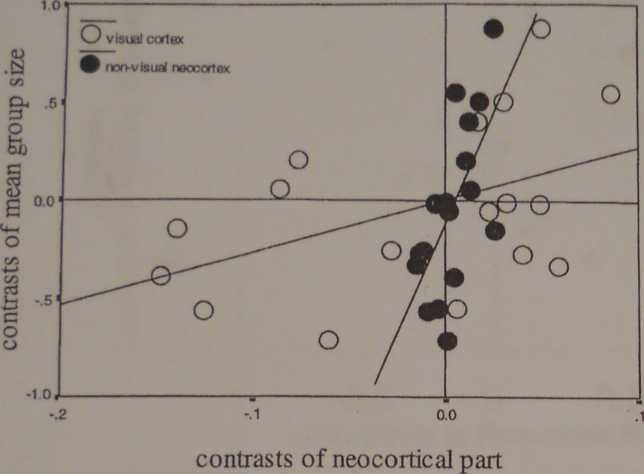DSCN4365
ARTiC2.ES Evolutlonary Anthropology 185
ARTiC2.ES Evolutlonary Anthropology 185

Figurę 4. independent contrasts in mean group size plotted against contrasts In the visual cortex and the volume of the rest of the neocortex (nonvisual neocortex) for individual anthropoid species. Notę that the visual cortex is here defined as visual area VI; the nonvisual cortex is the non-V1 volume of the neocortex and thus includes some higher order visual Processing components (e.g., visual area V2). Unfortunately, the data base of Stephan, Frahm, and Baron29 does not allow usto define our measure of the nonvisual area any morę finely than this. (Reprinted from Joffe and Dunbar.28 Fig. 1.)
the rates wlth whlch tactlcal deceptton are used correlate wlth neocortex slze.28 Species wlth large neocortex ratlos make significantly morę use of tactlcal deceptlon, even when the dlf-ferentlal freąuencles wlth whlch these large-bralned species have been stud-ied are taken into accounl.
Third, Pawłowski, Dunbar, and Lowen47 have shown that among po-lygamous prlmates the małe rank cor-relation wlth matlng success Is nega-tiveły related to neocortex size (Fig. 5). This is Just what we would predict if the lower ranking males of species wlth larger neocortlces were able to use thelr greater computat ional capacl-ties to deploy morę sophistteated so-clal skllls, such as the use of coalitions and capltalizing on female matę cholce, to undermine or circumvent the power-based strategles of the dominant animals.
involved. These Interactions could oc-cur between the sensory and associa-tłon cortlces (percelvlng an object), between the association and frontal cortlces (rememberlng an object), and among all three (belng aware of per-celvlng an object). It ls worth noting in this context that although social skllls are commonly disrupted by damage to the prefrontal cortex, memory for events and people ls not.42
It seems unlikely that emotional re-sponses per se are the substantive constraint. Although the correct emis-slon and interpretation of emotional cues is of slngular Importance in the management of social relationships,45 there is little evldence that the subcor-tical areas prlnclpally associated wlth emotional cuing (for example, the amygdala in the limbie system) corre-late in any way wlth social group size,28 Indeed, Keveme, Martel, and Nevison46 point out that there has been progressive reduction In the rela-tive sizes of the "emotionar centers in the brain (the hypothalamus and sep-tum) in favor of the “executive" centers (tlie neocortex and striate cortex) during primate evolutlon. They inter-pret this in terms of a shift away from emotional control of behavłor to morę conscious, deliberate control.
The only remaining alternative is that the mechanisms involved Ile in the ability to manipulate Information about social relationships themselves. This clalm is supported by slx addi-tional lines of evidence that point to the fundamental importance of social skllls In the detailed management of social relationships.
One is the fact that close analysis of the data on group size and neocortex volume suggests that there are, in fact, distinct grades even wlthin the anthropoid prlmates (Fig. 3). Apes seem to lie on a separate grade from the monkeys, which in tum lie on a separate grade from the prosimians. The slope coeffl-cients on these separate regresslon lines do not differ significantly, but the intercepts do. It is as if apes reąuire morę computing power to manage the same number of relationships that monkeys do, and monkeys ln turn require morę than prosimians do. This gradatlon corresponds closely to the percelved scaling of social complexity.
The second linę of evidence is that
... there is no intrinsic reason to suppose that memory per se is the issue. The social brain hypothesis is about the ability to manipulate Information, not simply to remember it.
The fourth Une of evidence is Jof-fe's48 demonstratlon that adult neocor-tex size in prlmates correlates with the length of the juvenile period, but not with the length of gestation, lactatlon, or the reproductive life span, even though total brain size in mammals correlates wlth the length of the gestation period.49-50 This suggests that what ls most important in the development of a large neocortex in prlmates is not the embryological development of brain tissue per se, which ls associated mainly wlth gestation length, but rather the "software programming" that occurs during the period of social learning between weaning and adult-hood.
Fifth, Kudo, Lowen, and Dunbar51 have shown that grooming cliąue size, a surrogate varlable that indexes alli-
Wyszukiwarka
Podobne podstrony:
DSCN4361 articl.es Evolutionary Anthropology 181 For this reason, Jerison derived his encephalizatio
DSCN4362 182 fc volutlonaty Anthropology Atmcus* 182 fc volutlonaty Anthropology Atmcus* -1.69 0.107
DSCN4364 AftTiGLES 184 EvoMJonary Anthropołogy CO CL a p s. O c m 9 s 10 & 3*
5 185 « Figurę A.3 Representation de la chambre climatique utilisee (60 L de volume utile). Le
wstęp do teorii polityki img 195 185 • niezależną (independent) państwo deklarując
DSCN4366 186 Evolutionary Anthropology ARTIO.CS 186 Evolutionary Anthropology
DSCN4367 ARTKLES Evolutlonary Anthropołogy 187 G Mean Group Size o ° o o DOO O ° °
DSCN4368 188 Evolutionary Anthropdogy ARTICLJUBox 2. A Beginner s Guide to Intensionaiity Computers
skanuj0014 (137) A HM: ES A. < W Ć rfg..... vJ: ;Ć ~ir — : ? ■ J -S ....... j......i
skanuj0021 (257) xco o^^ ^ n es t-n e n v (pjJoJjLoXA iedV obA/Ofcbi fe /fi- -Inn^ Om ■Sł^JiAL t-ĄO
skanuj0022 V .-^, 4S>^eS .,r“> "^tT . ^ ^
więcej podobnych podstron